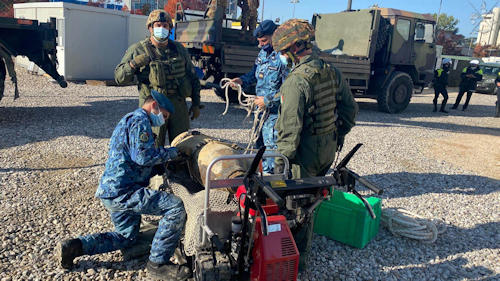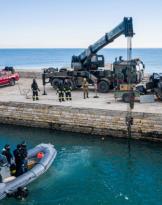The Army bombers from the 8th Parachute Engineer Regiment and the divers of the Underwater Operating Group ("GOS") of the Command Underwater Raiders of the Navy, intervened in Mestre, in the municipality of Venice, to defuse and neutralize a dangerous remnant of war dating back to the Second World War.
The bomb, a US-made aircraft bomb weighing 500 pounds (227 kg) with high explosive potential, was found in recent weeks inside the Cà Foscari university campus during some excavation works.
The delicate reclamation operations, coordinated by the Prefecture of Venice, began at 7 am today, at the end of the evacuation procedures for the population (about 500 residents).
The intervention was divided into two phases, first the Army paratrooper bomb squads removed the fuzes, still active, present on the bomb making it harmless, then the residue was transferred, along closed roads with no traffic, to the point of meeting with the personnel of the GOS seconded from the SDAI Nucleo of Ancona (Demining Defense Antimezzi Insidiosi), for the subsequent towing and neutralization through blasting on the high seas.

This movement, which took place in a convoy made up of Coast Guard patrol boats and SDAI Nucleus vehicles, crossed the lagoon, exiting the southern passage of Malamocco, until it reached the point established for blasting operations about 3 miles off the coast of Venice. . This area has been identified by the competent authorities to ensure the safety of the installations and preserve the marine ecosystem. At the end of two hours relating to the delicate operations of despolettamento and transfer, at 15:20 the blasting of the bomb occurred and the metropolitan city of Venice was able to return to normal.
To ensure the maximum safety framework, the engineers have created a mitigation structure resulting from a project developed by the Center of Excellence C-IED (Counter-Improvised Explosive Device) of the Army following two years of experimentation. The complex work made it possible to significantly reduce the clearance radius by reducing it to about 460 linear meters instead of the 1.600 normally envisaged. This reduction allows significant savings for the local community.
 The discovery of unexploded military devices in Italy is still a frequent phenomenon today, more than seventy years after the end of the Second World War. In fact, every year there are thousands of interventions by the Army engineering units for the findings on the ground and by the Navy for interventions in water (rivers, lakes, sea).
The discovery of unexploded military devices in Italy is still a frequent phenomenon today, more than seventy years after the end of the Second World War. In fact, every year there are thousands of interventions by the Army engineering units for the findings on the ground and by the Navy for interventions in water (rivers, lakes, sea).
Since the beginning of the year the 8th Parachute Engineer Regiment of the brigade thunderbolt conducted 300 reclamation interventions for a total of about 800 neutralized devices (of which 14 aircraft bombs) in the seven provinces of competence.
EOD divers (Explosive Ordnance Disposal) of the GOS of the Navy, in the same period, neutralized 61 thousand explosive devices in 210 emergency interventions throughout the national territory.












